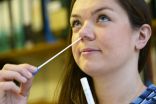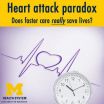Peanut in household dust linked to peanut allergy in children with eczema during infancy
2014-11-19
(Press-News.org) A new study led by researchers at King's College London in collaboration with the US Consortium of Food Allergy Research and the University of Dundee has found a strong link between environmental exposure to peanut protein during infancy (measured in household dust) and an allergic response to peanuts in children who have eczema early in life.
Around two per cent of school children in the UK and the US are allergic to peanuts. Severe eczema in early infancy has been linked to food allergies, particularly peanut allergy.
The study, published in the Journal of Allergy and Clinical Immunology, looked at the amount of peanut protein infants aged 3-15 months were exposed to in house dust, by vacuuming dust from the living room and measuring peanut in the dust. The study was conducted in 359 children who had a high risk of developing peanut allergy because they were allergic to cow's milk or egg or had moderate to severe eczema and had tested positive for an allergy to cow's milk or egg.
The study found that exposure to peanut in dust early in life doubled the risk of peanut allergy. In children with a history of eczema, the risk of peanut allergy increased further.
Dr Helen A Brough, first author from the Department of Paediatric Allergy, King's College London, said: "This study adds to the growing body of evidence that exposure to peanut via a damaged skin barrier may increase the risk of peanut allergy. Previous studies have shown, for example, that infants with eczema treated with creams containing peanut oil in the first six months of life had a higher risk of developing peanut allergy later in life."
Professor Gideon Lack, senior author from the Department of Paediatric Allergy, King's College London, said: "This is further evidence for the dual-allergen-exposure theory which suggests food allergies develop through exposure to allergens via the skin, likely through a disrupted skin barrier, whilst consumption of these food proteins early in life builds up tolerance in the body. Previous guidelines recommending that mothers should avoid peanuts during pregnancy and breastfeeding have now been withdrawn. It may be that the timing and balance of skin and oral exposure to a particular food early in life determines whether a child develops an allergy or tolerance to that food."
INFORMATION:
ELSE PRESS RELEASES FROM THIS DATE:
2014-11-19
New research on a number of Canadian lakes show that historical acid deposits as a result of industry have greatly reduced calcium levels in the water - dramatically impacting populations of calcium-rich plankton such as Daphnia water fleas that dominate these ecosystems.
Falling calcium levels mean Daphnia cannot get the nutrients they need to survive and reproduce, and are consequently consuming less food and becoming more susceptible to predators, leaving more algae for other organisms to feed on.
This has left a small jelly-clad organism called Holopedium to take ...
2014-11-19
People with airway diseases, including asthma and chronic obstructive pulmonary disease (COPD), have a higher incidence of inflammatory bowel disease, such as Crohn's disease and ulcerative colitis, according to the findings of a new study.
The research, which is published online today (19 November 2014) in the European Respiratory Journal, is the first population-based study to examine the association between airway diseases and the incidence of bowel disease. The news comes on World COPD Day, which aims to improve awareness and care of COPD.
The results showed that ...
2014-11-19
Researchers from the University of East Anglia (UEA) are a step closer to enhancing the generation of clean energy from bacteria.
A report published today shows how electrons hop across otherwise electrically insulating areas of bacterial proteins, and that the rate of electrical transfer is dependent on the orientation and proximity of electrically conductive 'stepping stones'.
It is hoped that this natural process can be used to improve 'bio batteries' which could produce energy for portable technology such as mobile phones, tablets and laptops - powered by human ...
2014-11-19
People taking part in this year's Flusurvey, the UK's biggest crowd-sourced study of influenza will for the first time be offered a swab to confirm if their symptoms are caused by a flu virus or not as part of a new collaboration with i-sense. Data from social media and internet searches will also be combined with Flusurvey, allowing flu trends to be monitored across the UK more accurately and earlier than ever before.
Flusurvey scientists at the London School of Hygiene & Tropical Medicine will analyse weekly information relating to symptoms, provided in an online questionnaire ...
2014-11-19
David King, clinical lecturer in paediatrics at the University of Sheffield, says medical professionals and consumers need to be aware that such devices "have no proved use in safeguarding infants or detecting health problems, and they certainly have no role in preventing [sudden infant death syndrome] SIDS."
Wearable devices for infants are a growing industry worldwide. Devices that attach to a newborn baby to monitor its vital signs are marketed by several US companies at a cost of around $200 to $300 to give parents "peace of mind" about their baby's health.
One ...
2014-11-19
The authors say their findings are applicable to law enforcement work outside the US and support the view that stressful work related activities can "trigger" sudden cardiac death.
Law enforcement is a dangerous occupation. In 2011-2012, the fatality rate among US patrol officers was 15-16 per 100,000 full time workers - about 3-5 times the national average for private sector employees.
Some evidence suggests that cardiovascular disease is higher among police officers than the general population, but data about the impact of specific on duty activities ...
2014-11-19
Observational studies have suggested that lower levels of vitamin D are associated with increased mortality, but whether low vitamin D concentrations are a cause of increased mortality or simply a consequence of poor health is thus unclear.
This is an important question, say the authors, as millions of people worldwide are regularly taking vitamin D supplements, presumably with the aim of preventing diseases and hopefully living longer.
Genetic variants have been reliably associated with circulating concentrations of vitamin D, a marker of vitamin D status. So a research ...
2014-11-19
Boston, MA -- Police officers in the United States face roughly 30 to 70 times higher risk of sudden cardiac death (SCD) when they're involved in stressful situations--suspect restraints, altercations, or chases--than when they're involved in routine or non-emergency activities, according to a new study from Harvard School of Public Health (HSPH) and Cambridge Health Alliance (CHA). It is the first study to provide data that demonstrates the impact of stressful duties on on-duty SCD.
The researchers also found that physical training activities--which police don't consider ...
2014-11-19
ANN ARBOR, Mich. -- A national effort to shave minutes off emergency heart attack treatment time has increased the chance that each patient will survive, a new study suggests. But yet the survival rate for all patients put together hasn't budged.
It seems like a paradox. But wait, say the authors of the new report: the paradox vanishes with more detailed analysis of exactly who has been getting this treatment.
Far more people are getting emergency angioplasty and stents for heart attacks now than before. That number now includes more people with more complicated health ...
2014-11-19
Barcelona, Spain: A phase I trial of the first drug designed to inhibit the cancer-causing activity of a mutated enzyme known as isocitrate dehydrogenase (IDH) 1, which is involved in cell metabolism, has shown clinical activity in patients with advanced acute myeloid leukaemia (AML) with the IDH1 mutation.
Professor Daniel Pollyea, M.D. will tell the 26th EORTC-NCI-AACR [1] Symposium on Molecular Targets and Cancer Therapeutics in Barcelona, Spain, today (Wednesday) that early results from the phase 1 clinical trial of the drug AG-120, an oral, selective and potent inhibitor ...
LAST 30 PRESS RELEASES:
[Press-News.org] Peanut in household dust linked to peanut allergy in children with eczema during infancy



